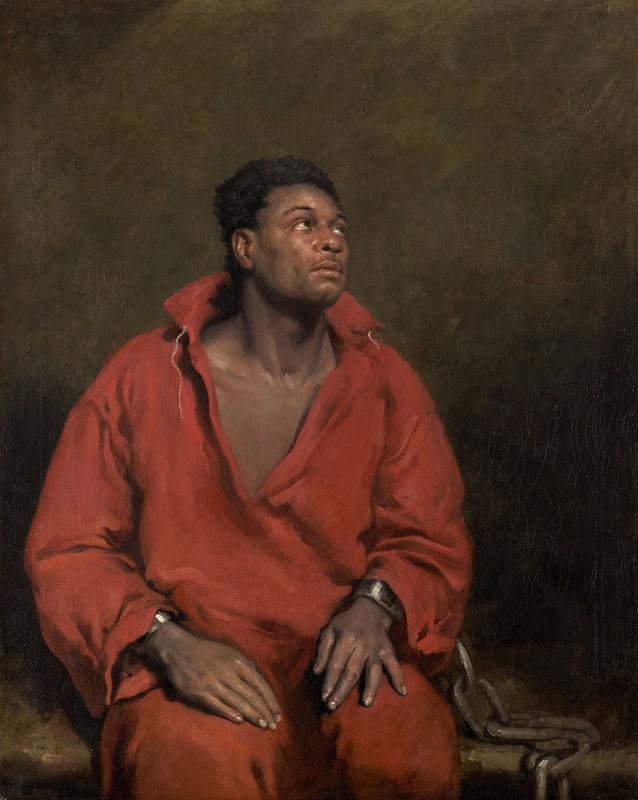More about The Captive Slave

Sr. Contributor
Despite using a contemporary celebrity as a model for multiple portraits, John Philip Simpson made the curious decision not to identify his subject.
There’s no denying that this is a rather rare painting for its time. After all, in 1827 there were not many portraits of enslaved people. The subject in question is Ira Frederick Aldridge, a Black actor from the United States who later moved to Britain in search of more opportunities on the stage. Aldridge also appears in at least one other painting by Simpson, which is currently known as Head of a Man (?Ira Frederick Aldridge) and is in the collection at Tate Britain. The Captive Slave decries the ills of slavery, and Head of a Man portrays Aldridge with dignity. However, Simpson did not always readily identify his subject. Why?
Showing Aldridge in heavy chains and with a forlorn look on his face, The Captive Slave ultimately supports the abolitionist cause. Simpson begs the viewer to consider how we have subjected others to such inhuman treatment. Aldridge’s upward gaze is central to the painting’s message. His hopeful gaze toward the heavens is modeled on images of martyrdom and saintly devotion. The Bible is rife with horrible stories of martyrs who suffered terrible deaths in the name of Christianity. Like these martyrs, Aldridge also looks up, representing the piety associated with biblical figures, as well as his longing for freedom – both in the painting and in the broader context of the millions of enslaved Black people worldwide. Head of a Man features the same pained, upward gaze.
Simpson’s choice to reverently portray a Black man was not the cultural norm for this time. In 1827, the British Empire was still in the midst of abolishing slavery. Although the British government outlawed the slave trade in 1807, slavery in the empire abroad did not formally end until 1833. This narrative was even more significant to Aldridge, who was born a free man in New York. The United States was still decades away from its first, far-from-perfect attempts at abolishing the institution of slavery, and racist attitudes informed Aldridge’s acting career. Aldridge found more success in Europe, where he became known for his performances of Shakespearean characters, and eventually became the first black actor to play Othello in London in 1833. Throughout his illustrious career, Aldridge toured Great Britain, Europe, and Russia, using his fame to drive his anti-slavery activism. Despite his increased access and ultimate success in Europe, Aldridge still faced racist critics who disparaged him for his appearance, rather than lauding him for his talents.
Aldridge’s fame earned him places in a number of other contemporary portraits. Other artists, like Henry Perronet Briggs, not only painted Aldridge but also identified him in the work’s title. Why didn’t Simpson do the same? Briggs was not as well-known as Simpson, so perhaps he wanted to use Aldridge’s notoriety to boost attention for his painting. Whereas Briggs’s portrait commemorated Aldridge’s role as Othello, Simpson’s painting had a more universal message, perhaps explaining his reluctance to identify the sitter. Whatever the reasons may be, we must not forget the important role that Aldridge played in increasing representation on the stage, as well as his ardent anti-slavery efforts.
Sources
- Art Institute of Chicago. “The Captive Slave.” The Collection. https://www.artic.edu/artworks/193664/the-captive-slave. Accessed 15 September 2020.
- Art Institute of Chicago. “The Captive Slave.” The Collection. https://www.artic.edu/artworks/193664/the-captive-slave. Accessed 15 September 2020.
- Smithsonian Institute. “Ira Aldridge, Actor and Activist.” National Museum of African American Culture and History. https://nmaahc.si.edu/ira-aldridge-actor-activist. Accessed 15 September 2020.
- Tate. “The Racial and Identity Politics of Head of a Man.” Art & artists. John Simpson. https://www.tate.org.uk/art/artists/john-simpson-495/racial-identity-po…. Accessed 15 September 2020.
Featured Content
Here is what Wikipedia says about The Captive Slave
The Captive Slave is a painting by British artist John Simpson, which was first exhibited in London in 1827. The portrait shows a man, manacled, on a stone bench and looking pensively or plaintively upward. Its subject matter, historical period, and mode of creation suggest the artist intended the painting as an abolitionist statement.
After being displayed again in 1828, the painting was not given another public showing for 180 years, until it was purchased by the Art Institute of Chicago in 2008.
Check out the full Wikipedia article about The Captive Slave












